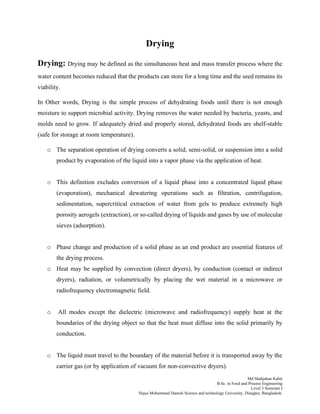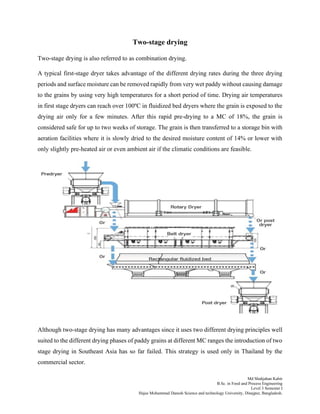The document discusses various aspects of drying, including definitions, purposes, processes, and factors that influence drying. Drying is defined as a heat and mass transfer process that reduces water content in a material to allow for long-term storage. Key points made include:
- Drying removes water needed by microbes to grow, allowing dehydrated foods to be shelf-stable.
- Heat transfer and moisture transfer are the two events that occur in drying.
- Drying methods include heated air, sun, solar, shed, spray drying, and freeze drying.
- Factors like temperature, time, moisture content, and pressure influence drying rates.
















![Md Shahjahan Kabir
B.Sc. in Food and Process Engineering
Level 3 Semester I
Hajee Mohammad Danesh Science and technology University, Dinajpur, Bangladesh.
Advantage of osmotic drying
1. Minimized heat damage to fruits and vegetables while drying
2. Least discoloration of fruits by enzymatic browning.
3. Increase retention of volatile, flavors and aroma.
4. Improved textural quality and lower energy consumption than air drying.
Disadvantages of osmotic drying
The main disadvantage of the osmotic process is that it may increase the saltiness or sweetness or
decrease the acidity of the product thus reduces the characteristic taste of some products
Vacuum Drying
Vacuum drying is the mass transfer operation in which the moisture present in a substance, usually
a wet solid, is removed by means of creating a vacuum. In chemical processing industries like food
processing, pharmacology, agriculture, and textiles, drying is an essential unit operation to remove
moisture.[1]
Vacuum drying is generally used for the drying of substances which
are hygroscopic and heat sensitive, and is based on the principle of creating a vacuum to decrease
the chamber pressure below the vapor pressure of the water, causing it to boil. With the help of
vacuum pumps, the pressure is reduced around the substance to be dried. This decreases the boiling
point of water inside that product and thereby increases the rate of evaporation significantly. The
result is a significantly increased drying rate of the product.[2]
The pressure maintained in vacuum](https://image.slidesharecdn.com/drying-240214170133-44e94f18/85/Drying-pdf-17-320.jpg)






